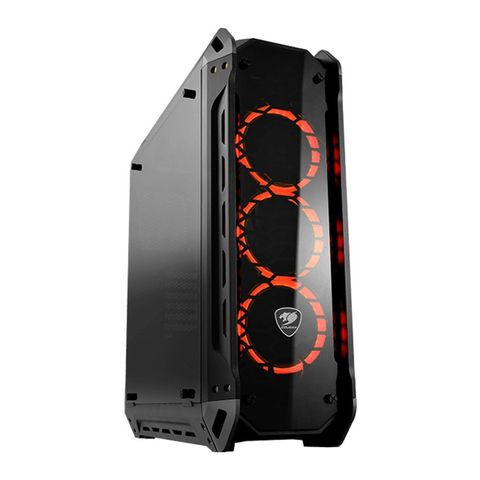Tom's Hardware Verdict
The Cougar Panzer G is a feature-rich chassis with broad appeal and great performance. The sharp lines and aggressive style might not be for everyone but the chassis’ overall performance will delight gamers, overclockers and performance enthusiasts alike. The tempered-glass side panels and LED-lit fans are just the cherry on top.
Pros
- +
Great Thermal Performance
- +
Best In Class Audio Performance
- +
Tempered Glass Side Panels
- +
Three 120mm LED Fans
- +
Attractive Aggressive Styling
Cons
- -
Price (For Some)
- -
No USB Type-C port
Why you can trust Tom's Hardware
Features & Specifications
With its bold lines and aggressive styling, all wrapped in tempered glass and filled with the company's new vortex LED fans, Cougar's Panzer G chassis might be ideal the case for buyers who are tired of monolithic designs. With its top-notch cooling performance and rugged good looks, this mid-tower case has a lot to offer, but its $120 price is a little on the high side.
Well known in the enthusiast PC community, Cougar has spent the last decade refining its "Real Gear for Real Gamers" approach across a line of products that includes power supplies, gaming peripherals and computer chassis. The latter is what brings us here today.
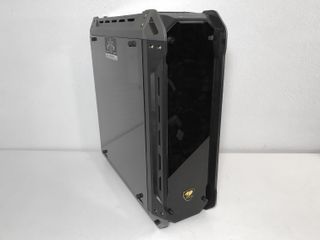
Exterior
Cougar’s new Panzer G features tempered glass panels on the left, right, top, and front sides, with a symmetrical frame that resembles metal crossbars. If this design looks familiar, that is because the company has used this aesthetic on several of its Panzer series chassis (if it isn't broke, don't fix it). This industrial design seems to be increasingly popular with other case manufacturers as well. The Cooler Master MasterCase H500P Mesh is a good example of a chassis with a similar crossbar frame design.




Measuring 565 x 208 x 520mm (HWD) and tipping the scales at just under 25lbs, the Panzer G's rather imposing design is constructed of steel, plastic, and tempered glass panels. The black on black paint scheme gives this chassis a bit of an ominous, sinister look. The top panel of this chassis is darkly tinted tempered glass, held in place with four thumbscrews, with mounting locations for two 120mm or 140mm fans and a magnetic mesh filter directly under it. The area where the top and front panels meet is home to two USB 2.0 ports, a pair of USB 3.0 ports, a large power button, and headphone and microphone jacks.
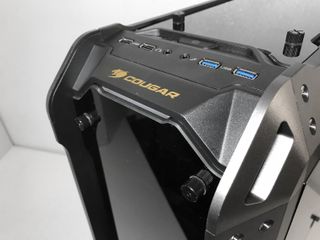
The left, right, and front panels are tempered glass as well. Like most cases equipped with tempered glass panels, the Panzer G uses rubber-coated locating pins and thumbscrews to secure the panels to the frame. Air intake vents on either side of the top and front panels provide a direct path for fresh air to be drawn into the chassis. The front and top panels have cut-outs along the sides to allow air into the chassis as well. Much like the FSP CMT510, tabs at the bottom of the side panels require tilting them 45° out and away from the chassis before lifting them up and off the frame.



The bottom of the case has two filter-covered holes, one for the power supply, one for an optional 120mm fan, as well as four large, rubber-coated plastic feet.
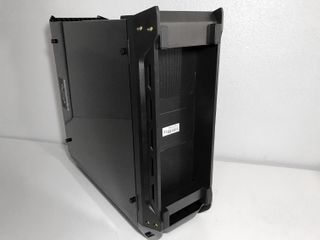
The rear of the chassis is home to seven card slots, a motherboard I/O area, an opening for a bottom-mounted PSU, and an exhaust-fan mounting location for 120mm fans.
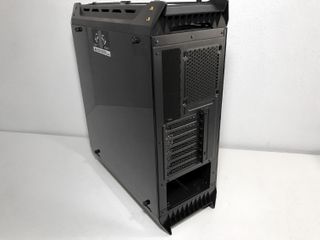
The fan filtration system is fairly robust in terms of its ability to prevent most dirt and dust particles from entering your system. As mentioned earlier, the metal mesh filter on the top of the case is attached by magnetic seals at the edge of the filter. The large filter in the front of the chassis also attaches to the frame via magnets. The weak point in the filtration system would be the filters located in the bottom of the chassis. Cleaning and maintenance requires turning your system complete on its side. A third magnetic filter in this location would be a better solution.




Specifications
| Type | Mid Tower |
| Motherboard Support | CEB, ATX, mATX, Mini-ITX |
| Dimensions (HxWxD) | 565 x 208 x 520mm |
| Space Above Motherboard | 1.5” + 1.5” recess (39 + 39mm) |
| Card Length | 400mm (424mm w/o front fans) |
| Power Supply Format | Standard ATX PS/2 |
| Weight | 11.25 kg |
| External Bays | (0) 5.25" |
| Internal Bays | (2) 3.5", (4) 2.5" (2 converted from 3.5" bays) |
| Card Slots | 7 |
| Ports/Jacks | (2) USB 2.0, (2) USB 3.0, (1) Audio/Mic |
| Other | LED-lit fans, tempered glass on four sides |
| Front Fans | 3x 120 mm LED fans |
| Rear Fans | ✗ |
| Top Fans | ✗ |
| Bottom Fans | ✗ |
| Side Fans | ✗ |
| Dampening | ✗ |
MORE: Best Cases
MORE: All Case Content
-
WildCard999 Odd this didn't earn a TH choice award as it's a really nice case for the price. I would love to see a Gigabyte Aorus motherboard in this case with some orange RGB/LED RAM modules.Reply -
Larmo-Ct I hate to be the "Ugly American" here. But it would be convenient for all of the measurements to be calculated in both millimeters and inches. Also, the whole tempered glass trend in current cases, seems to be a little extreme, and adds weight to the cases. With the way some of the shipping companies handle packages. I shutter to think how some of the glass components will arrive. My older cases have done quite well with transparent plastic sides, not to mention one that has two aluminum sides with no transparency. Lastly, it seems that few, if not none, of the major case manufacturers care that some consumers. Still have optical drives and card readers. So will external drives be the only answer, when a new case is purchased in the future? :-(Reply -
Crashman Reply
I can't even be sure he's actually measuring these rather than repeating factory specs. For years you were treated to actual measurements that included protrusions (such as thumb screws), in both inches and cm, so that you'd be able to tell if it fit your shelf, which was usually measured in inches. And I was personally adding the motherboard depth measurement because so many "EATX" boards are only 10.6", and so many "ATX" cases support more than 10.6". But then we lost a couple motherboard editors, and putting the case reviews into the hands of a different reviewer was the easiest way for me to personally have time to review more motherboards. The new big-case reviewer's methods are slightly different, but he still knows what he's doing, so I ask only that you do your conversions (divide by 25.4 to get inches, for example), forget about squeezing these into tight spaces, and limit your pestering of the author to questions about maximum motherboard depth.20986262 said:I hate to be the "Ugly American" here. But it would be convenient for all of the measurements to be calculated in both millimeters and inches. Also, the whole tempered glass trend in current cases, seems to be a little extreme, and adds weight to the cases. With the way some of the shipping companies handle packages. I shutter to think how some of the glass components will arrive. My older cases have done quite well with transparent plastic sides, not to mention one that has two aluminum sides with no transparency. Lastly, it seems that few, if not none, of the major case manufacturers care that some consumers. Still have optical drives and card readers. So will external drives be the only answer, when a new case is purchased in the future? :-(
